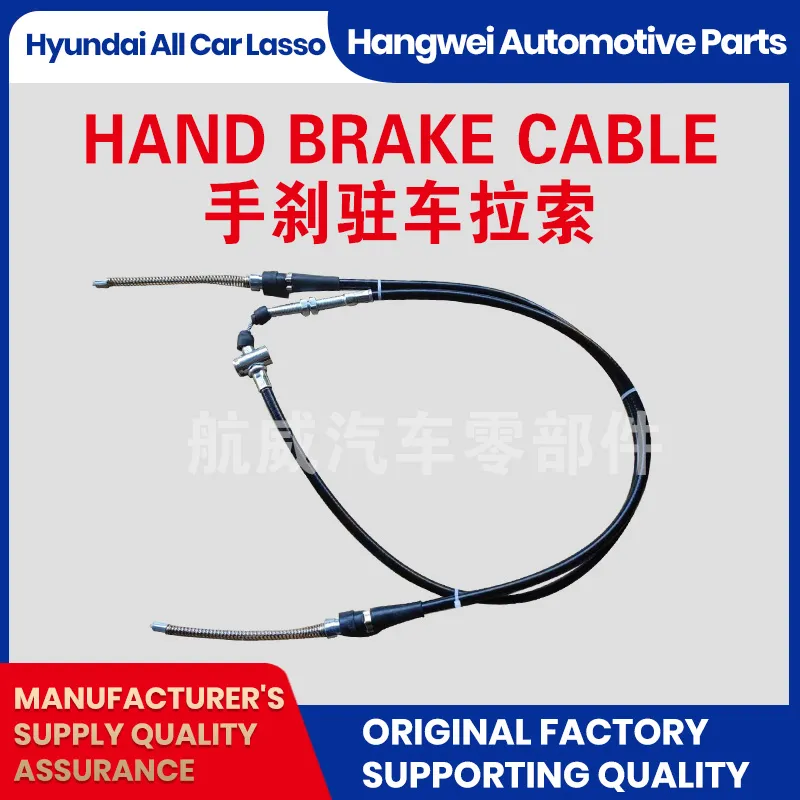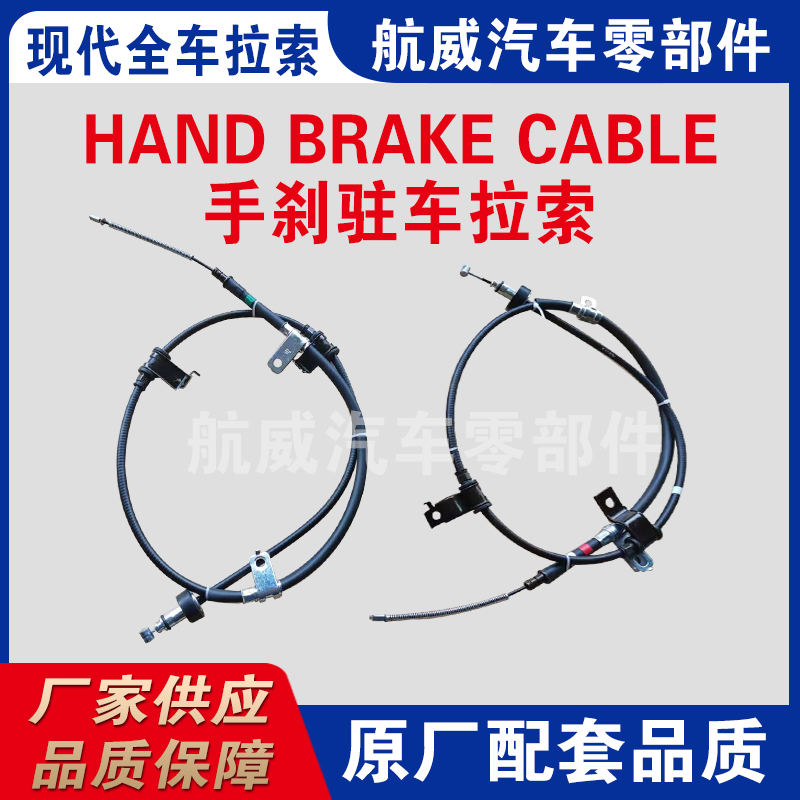High-Quality Hand Brake Cable | Custom & Universal Solutions
Navigating the Essentials of Hand Brake Cable Technology
In the realm of mechanical and automotive engineering, the hand brake cable stands as a critical, yet often overlooked, component. This vital assembly ensures the secure parking of vehicles and machinery, providing essential safety and operational stability. Beyond its common automotive application, the role of a hand brake cable extends across a diverse spectrum of industrial equipment, material handling systems, and even specialized agricultural machinery. Understanding the nuanced technical specifications, manufacturing precision, and robust application requirements of these cables is paramount for B2B decision-makers, engineers, and procurement specialists. The market for high-quality brake cables is driven by an increasing demand for enhanced safety standards, durability under extreme conditions, and tailored solutions for complex mechanical systems. Manufacturers are continually innovating, focusing on superior materials and advanced production methodologies to meet stringent industry benchmarks.
The evolution of the ebrake cable, or cable handbrake, has been significantly influenced by advancements in material science and precision engineering. Modern designs prioritize reduced friction, improved corrosion resistance, and extended service life, even in highly corrosive or abrasive environments. Key industry trends indicate a shift towards universal designs that offer greater adaptability, alongside a growing demand for handbrake cables made to order, catering to highly specialized applications. Whether it's a robust trailer handbrake cable requiring exceptional tensile strength or intricate custom handbrake cables for robotics, the underlying principles of reliable force transmission and long-term performance remain central. This comprehensive overview delves into the critical aspects of these components, from their intricate manufacturing processes to their diverse applications and the key considerations for selecting a dependable supplier.
The Precision Engineering Behind Hand Brake Cables
The manufacturing of a high-performance hand brake cable is a multi-stage process demanding meticulous attention to detail and adherence to rigorous quality control protocols. It typically begins with the selection of premium materials, such as high-carbon steel wire for the inner cable core, often galvanized or stainless steel to enhance corrosion resistance and durability. The outer casing, crucial for protecting the inner cable and facilitating smooth operation, is commonly constructed from extruded polymers like HDPE or PVC, sometimes reinforced with steel coils for added rigidity and resistance to external damage. End fittings, which connect the cable to the brake mechanism and lever, are precisely engineered through processes like cold forging, stamping, or CNC machining from materials such as mild steel, brass, or aluminum alloys. These components are then often zinc-plated or powder-coated to prevent rust and improve aesthetic appeal.
The assembly process involves precisely cutting the inner cable to specified lengths, applying a low-friction liner within the outer casing, and then expertly crimping or swaging the end fittings onto both ends of the inner cable. This critical step ensures a secure, permanent connection capable of withstanding significant tensile loads. Throughout production, strict quality assurance measures are applied. Cables undergo extensive testing for tensile strength, flexibility, friction coefficient, and resistance to environmental factors like temperature extremes and moisture. Compliance with international standards such as ISO 9001 for quality management and specific product performance standards like ANSI or SAE is non-negotiable, ensuring each handbrake cable meets the required operational benchmarks and offers an extended service life, typically ranging from 100,000 to 200,000 cycles, depending on application and maintenance.

Technical Specifications and Performance Benchmarks
The performance of a hand brake cable is quantifiable through several critical technical parameters, essential for engineers to specify the correct component for their application. These parameters include tensile strength, which dictates the maximum load the cable can withstand before breaking, typically measured in kilonewtons (kN). The outer diameter and inner cable diameter influence flexibility and the force required for operation. Crucially, the operating temperature range indicates the environmental conditions under which the cable maintains optimal performance, often spanning from -40°C to +100°C for standard applications, with specialized variants tolerating more extreme temperatures. Wear resistance and corrosion resistance are also key, often enhanced through coatings or material selection, impacting the longevity of the cable hand brake.
Below is a table summarizing typical parameters for various types of handbrake cables, reflecting common industry specifications. These values highlight the diversity in design and material choice aimed at optimizing performance for specific functional requirements, from standard automotive applications to heavy-duty industrial uses that demand high robustness.
| Parameter | Standard Automotive Cable | Heavy-Duty Industrial Cable | Marine/Corrosion-Resistant Cable |
|---|---|---|---|
| Inner Cable Material | Galvanized Steel | High-Carbon Steel (e.g., 1070) | Stainless Steel (e.g., 304, 316) |
| Outer Casing Material | PVC/HDPE with Steel Reinforcement | PE/PA with Spiral Steel Liner | HDPE/UV-Stabilized Polymer |
| Tensile Strength (kN) | 2 - 5 kN | 5 - 15 kN | 3 - 8 kN |
| Operating Temp. Range (°C) | -40 to +80 | -50 to +120 | -30 to +90 |
| Service Life (Cycles) | 100,000 - 150,000 | 200,000 - 500,000+ | 150,000 - 300,000 |
| Corrosion Resistance | Good (Galvanized) | Very Good (Coated/Plated) | Excellent (Stainless Steel) |
Diverse Applications Across Industries
The versatility of hand brake cables is evident in their wide array of applications across various industries, far beyond just conventional passenger vehicles. In the automotive sector, they are crucial for both manual and electric parking brake systems in cars, trucks, and buses. Furthermore, their robust construction makes them indispensable in heavy machinery, including construction equipment like excavators and bulldozers, where reliable parking brakes are vital for operational safety on uneven terrain. The agricultural sector also extensively utilizes these cables in tractors, harvesters, and specialized implements, ensuring equipment stability during field operations.
Beyond mobile applications, ebrake cables play a significant role in industrial settings. In material handling, they are integral to conveyor systems, industrial lifts, and hoists, providing emergency braking capabilities. In specialized sectors such as petrochemical, metallurgy, and water supply/drainage, where harsh environmental conditions are common, specially designed corrosion-resistant and high-temperature-tolerant cable handbrake solutions are essential. These applications often benefit from custom configurations, where specific lengths, end fittings, and materials are required to meet unique operational demands. For instance, in mining, handbrake cables made to order with enhanced abrasion resistance are critical for durable performance in harsh, dusty environments, contributing to increased safety and reduced downtime.
Customization and Supplier Selection
Given the broad range of applications and varying operational demands, the ability to procure custom handbrake cables is a significant advantage for many businesses. Leading manufacturers offer comprehensive customization services, allowing clients to specify cable length, inner cable material (e.g., galvanized, stainless steel), outer casing composition, and a diverse range of end fittings including clevis pins, threaded rods, and specialized quick-release mechanisms. This bespoke approach ensures optimal fit and performance, eliminating the compromises often associated with off-the-shelf solutions. Whether it's a unique trailer handbrake cable requirement or a complex industrial control system, expert consultation and tailored manufacturing capabilities are crucial.
When selecting a supplier for handbrake cables, B2B buyers should prioritize manufacturers with a proven track record of quality, adherence to international standards (like ISO 9001, TS 16949), and a strong commitment to R&D. Consider their material sourcing policies, manufacturing process controls, and internal testing capabilities. A supplier offering robust technical support, design assistance for universal handbrake cable applications, and a clear warranty policy indicates a reliable partnership. Look for companies that provide detailed performance data, case studies, and transparent communication regarding lead times and delivery logistics, ensuring a seamless procurement process and long-term product reliability.

Ensuring Trust: Quality Assurance, Delivery, and Support
Establishing trust with a supplier of critical components like handbrake cables is paramount for B2B relationships. A reputable manufacturer differentiates itself through transparent quality assurance processes, which include rigorous material inspection, in-process quality checks, and comprehensive final product testing. Certifications such as ISO 9001 are foundational, indicating a commitment to consistent quality management. Some leading suppliers also hold specific industry certifications or have undergone third-party audits to demonstrate product compliance with stringent performance and safety standards. Partnership with established automotive OEMs or heavy equipment manufacturers further underscores their reliability and expertise in producing high-volume, defect-free handbrake cables.
Frequently Asked Questions (FAQ)
- Q: What is the typical lead time for custom handbrake cables?
A: Lead times vary depending on complexity and order volume. Standard custom orders typically range from 3-5 weeks after design approval, while urgent requests may be accommodated with expedited options. - Q: Do you provide design assistance for unique applications?
A: Absolutely. Our engineering team specializes in collaborative design, offering expertise in material selection, end-fitting design, and routing optimization to ensure your cable hand brake meets specific operational challenges. - Q: What warranty is offered on your hand brake cables?
A: We offer a standard 12-month warranty against manufacturing defects for all our handbrake cables, underscoring our confidence in product quality and durability. Extended warranty options may be available for specific projects. - Q: How do you ensure product consistency and traceability?
A: We implement a robust quality management system with batch tracking, detailed inspection records, and strict process controls. Each ebrake cable batch is fully traceable from raw material to finished product, ensuring consistent performance.
In terms of delivery, reliable suppliers offer flexible logistics solutions, including global shipping capabilities and strategic warehousing to minimize transit times and reduce inventory costs for their clients. A clear delivery schedule and proactive communication regarding order status are hallmarks of trustworthy service. Post-purchase support is equally vital; this includes technical assistance for installation or troubleshooting, and responsive customer service for any inquiries or feedback. By prioritizing these elements, businesses can ensure a consistent supply of high-quality handbrake cables, contributing to operational efficiency and safety.
Conclusion: The Indispensable Role of Quality Hand Brake Cables
The hand brake cable, while seemingly simple, is a sophisticated engineered component that underpins safety and functionality across an extensive range of mechanical and industrial systems. From ensuring vehicle parking stability to enabling critical braking in heavy machinery and providing essential control in specialized industrial applications, its reliability is non-negotiable. The industry's evolution continues to focus on advanced materials, precision manufacturing techniques, and rigorous quality control to meet the escalating demands for durability, performance, and adaptability.
For B2B buyers and engineers, understanding the intricate details of material science, manufacturing processes, technical specifications, and the scope for customization in handbrake cables is crucial for making informed procurement decisions. Partnering with a manufacturer that not only offers a comprehensive range of standard and custom handbrake cables but also exemplifies expertise, experience, authority, and trustworthiness through robust quality assurance, transparent communication, and dedicated customer support, is key to achieving operational excellence and ensuring long-term safety and efficiency in any application.
References
- Society of Automotive Engineers (SAE) Standards, J2530: Test Procedures for Brake Cables.
- International Organization for Standardization (ISO) 9001: Quality management systems – Requirements.
- National Institute for Automotive Service Excellence (ASE) certifications for braking systems.
- Materials Science and Engineering: An Introduction, 10th Edition.
-
Clutch Line: Braided, Leak-Proof, OEM-Grade PerformanceNewsNov.10,2025
-
Throttle Cable: Durable, Smooth Control & Universal FitNewsNov.10,2025
-
Throttle Cable: Durable, Smooth, Universal Fit, Easy InstallNewsNov.10,2025
-
Clutch Line: Durable, Leak-Proof, OEM-Grade PerformanceNewsNov.10,2025
-
Hand Brake Cable | Custom, Universal & Trailer SolutionsNewsNov.10,2025
-
Clutch Line: High-Pressure, OEM-Fit, Corrosion-ResistantNewsNov.03,2025
